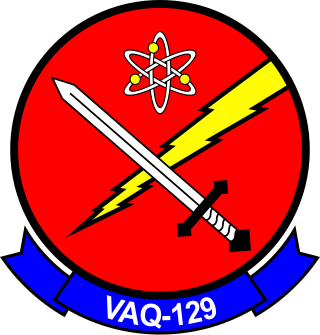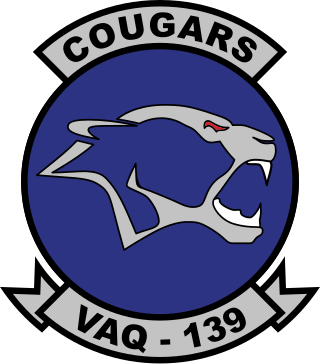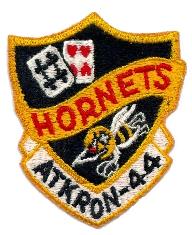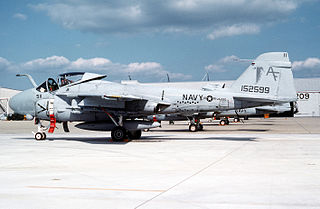
The Northrop GrummanEA-6B Prowler is a twin-engine, four-seat, mid-wing electronic-warfare aircraft derived from the A-6 Intruder airframe. The EA-6A was the initial electronic warfare version of the A-6 used by the United States Marine Corps and United States Navy. Development on the more advanced EA-6B began in 1966. An EA-6B aircrew consisted of one pilot and three Electronic Countermeasures Officers, though it was not uncommon for only two ECMOs to be used on missions. It was capable of carrying and firing anti-radiation missiles (ARMs), such as the AGM-88 HARM.

The Douglas A-3 Skywarrior is a jet-powered strategic bomber that was developed and produced by the Douglas Aircraft Company. It was designed by Douglas on behalf of the United States Navy, which sought a carrier-capable strategic bomber. During July 1949, Douglas was awarded the contract to produce its design, having bested eight other aircraft companies' submissions. Unlike rival designs, which had aimed for a 100,000 lb (45,000 kg) maximum take-off weight, the Skywarrior was developed for a 68,000 lb (31,000 kg) take-off weight, facilitating its use from the navy's existing Midway-class aircraft carriers. Large portions of the aircraft were produced by the Westinghouse Electric Corporation, including its early Westinghouse J40 turbojet engines, which failed to meet promises and were replaced by the rival Pratt & Whitney J57 engine by mid-1953. On 28 October 1952, the prototype XA3D-1 performed the type's maiden flight.
The Dictionary of American Naval Aviation Squadrons (DANAS) is a multivolume work published by Naval Historical Center of the U.S. Department of the Navy's Naval History & Heritage Command. It covers naval aviation in much the same way as the Dictionary of American Naval Fighting Ships (DANFS) covers commissioned vessels.

Electronic Attack Squadron 129 (VAQ-129) is the United States Navy's only EA-18G Growler training squadron. Known as the "Vikings", they are a Fleet Replacement Squadron, or FRS, and are charged with training all EA-18G aviators and developing standard operating procedures for the maintenance and operation of the aircraft. The squadron is permanently stationed at Naval Air Station Whidbey Island, in Puget Sound, Washington.
A naval flight officer (NFO) is a commissioned officer in the United States Navy or United States Marine Corps who specializes in airborne weapons and sensor systems. NFOs are not pilots (naval aviators), but they may perform many "co-pilot" or "mission specialist" functions, depending on the type of aircraft. Until 1966, their duties were performed by both commissioned officer and senior enlisted naval aviation observers (NAO).

A carrier air wing is an operational naval aviation organization composed of several aircraft squadrons and detachments of various types of fixed-wing and rotary-wing aircraft. Organized, equipped and trained to conduct modern US Navy carrier air operations while embarked aboard aircraft carriers, the various squadrons in an air wing have different but complementary missions, and provide most of the striking power and electronic warfare capabilities of a carrier battle group (CVBG). While the CVBG term is still used by other nations, the CVBG in US parlance is now known as a carrier strike group (CSG).

The Tactical Support Wing (TSW) is one of three reserve aircraft wings of the United States Navy. The wing reports to the Commander, Naval Air Force Reserve. It is headquartered at Naval Air Station Joint Reserve Base Fort Worth, Texas along with the reserve's Fleet Logistics Support Wing (FLSW). The third reserve wing is the Maritime Support Wing (MSW) which is headquartered at Naval Air Station North Island, California. The wing's primary mission is operational and training support for active forces. It is composed of five flying squadrons.

Electromagnetic Attack Squadron 139 (VAQ-139), also known as the "Cougars", is an EA-18G Growler squadron of the United States Navy. They specialize in electromagnetic attack and are currently stationed at Naval Air Station Whidbey Island, Washington. Part of Carrier Air Wing Seventeen, the Cougars deploy aboard the aircraft carrier USS Nimitz

The United States Marine Corps Aviation (USMCA) is the aircraft arm of the United States Marine Corps. Aviation units within the Marine Corps are assigned to support the Marine Air-Ground Task Force, as the aviation combat element, by providing six functions: assault support, antiair warfare, close air support, electronic warfare, control of aircraft and missiles, and aerial reconnaissance. The Corps operates rotary-wing, tiltrotor, and fixed-wing aircraft mainly to provide transport and close air support to its ground forces. Other aircraft types are also used in a variety of support and special-purpose roles. All Marine Corps aviation falls under the influence of the Deputy Commandant for Aviation, whose job is to advise the Commandant of the Marine Corps in all matters relating to aviation, especially acquisition of new assets, conversions of current aircraft, maintenance, operation, and command.

Electromagnetic Attack Squadron 132 (VAQ-132), the "Scorpions", is a United States Navy aircraft squadron based at Naval Air Station Whidbey Island, flying the EA-18G Growler. The squadron's radio callsign is "Scorp".

Attack Squadron 44 (VA-44) was an attack squadron of the United States Navy. Originally established as Bombing Squadron VB-75 on 1 June 1945 it was redesignated Attack Squadron VA-3B on 15 November 1946, redesignated VA-44 on 1 September 1948 and disestablished on 8 June 1950. A second VA-44 was in service from 1 September 1950 until disestablishment on 1 May 1970.

The Commander, Naval Air Force Atlantic is the aviation Type Commander (TYCOM) for the United States Naval aviation units operating primarily in the Atlantic under United States Fleet Forces Command. Type Commanders are in administrative control (ADCON), and in some cases operational control (OPCON) of certain types of assets assigned to the Pacific and Atlantic Fleets. AIRLANT is responsible for the material readiness, administration, training, and inspection of units/squadrons under their command, and for providing operationally ready air squadrons and aircraft carriers to the fleet.

VAK-208 was a U.S. Navy Tactical Aerial Refueling Squadron. The squadron was established on 30 July 1970 as a Tactical Electronic Warfare Squadron 208 (VAQ-208), redesignated as VAK-208 on 1 October 1979 and disestablished on 30 September 1989.

VA-205, nicknamed the Green Falcons, was an Attack Squadron of the U.S. Naval Reserve, based at Naval Air Station Atlanta, Georgia. It was established on 1 July 1970 and disestablished on 31 December 1994.














